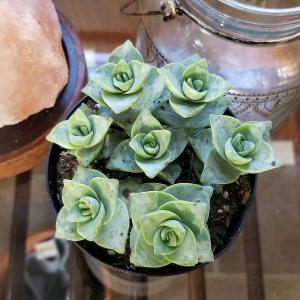植物经验
详细说明
Crassula perforata is a small shrubby and sprawling succulent, up to 18 inches (45 cm) tall. The stem is erect, fleshy, later prostrate and woody. Short, broad ovate, opposite, gray-green leaves edged in pink color with small whitish or pink dots on the margin, up to 0.8 inch (2 cm) long and up to 0.5 inch (13 mm) wide. The flowers are very small, star-shaped and white in color.
Growing Conditions
Light: Full sun to partial shade. Most needs some shade in the hottest part of summer, but require bright light to attain their most vibrant color.
Water: As succulents, they don’t need frequent watering, since they store it in their leaves. If they are left to sit in wet soil, their roots will rot. During cooler months, give them a good drenching and then allow the soil to dry out, before watering again. They go dormant when the temperature gets hot in summer and need even less water.
Temperature: Prefers average summer temps (65ºF/18ºC – 70ºF/21ºC). In winter, cool to 50ºF/10ºC.
Soil: A well-drained succulent mix, with an ideal pH around 6.0 (slightly acidic).
Fertilizer: Many people underfeed their succulents during the growing season. Feed with a controlled-release fertilizer in the beginning of the season or weekly with a weak liquid solution. Use a balanced 20-20-20 fertilizer at 1/4 strength on mature plants, and a fertilizer with less nitrogen on young plants.
Propagation
Crassula are generally started by division, offsets or leaf cuttings. Plants can be easily propagated from a single leaf: sprout leaves by placing them into a succulent or cacti mix, then covering the dish until they sprout.
Repotting
Repot as needed, preferably during the warm season. To repot a succulent, make sure the soil is dry before repotting, then gently remove the pot.
Knock away the old soil from the roots, making sure to remove any rotted or dead roots in the process. Treat any cuts with a fungicide. Place the plant in its new pot and backfill with potting soil, spreading the roots out as you repot. Leave the plant dry for a week or so, then begin to water lightly to reduce the risk of root rot.
Growing Conditions
Light: Full sun to partial shade. Most needs some shade in the hottest part of summer, but require bright light to attain their most vibrant color.
Water: As succulents, they don’t need frequent watering, since they store it in their leaves. If they are left to sit in wet soil, their roots will rot. During cooler months, give them a good drenching and then allow the soil to dry out, before watering again. They go dormant when the temperature gets hot in summer and need even less water.
Temperature: Prefers average summer temps (65ºF/18ºC – 70ºF/21ºC). In winter, cool to 50ºF/10ºC.
Soil: A well-drained succulent mix, with an ideal pH around 6.0 (slightly acidic).
Fertilizer: Many people underfeed their succulents during the growing season. Feed with a controlled-release fertilizer in the beginning of the season or weekly with a weak liquid solution. Use a balanced 20-20-20 fertilizer at 1/4 strength on mature plants, and a fertilizer with less nitrogen on young plants.
Propagation
Crassula are generally started by division, offsets or leaf cuttings. Plants can be easily propagated from a single leaf: sprout leaves by placing them into a succulent or cacti mix, then covering the dish until they sprout.
Repotting
Repot as needed, preferably during the warm season. To repot a succulent, make sure the soil is dry before repotting, then gently remove the pot.
Knock away the old soil from the roots, making sure to remove any rotted or dead roots in the process. Treat any cuts with a fungicide. Place the plant in its new pot and backfill with potting soil, spreading the roots out as you repot. Leave the plant dry for a week or so, then begin to water lightly to reduce the risk of root rot.
花相册 (1)

brielle
2017年10月01日

October 1, 2017







